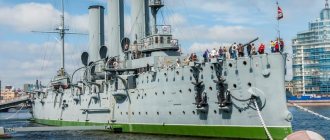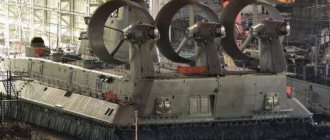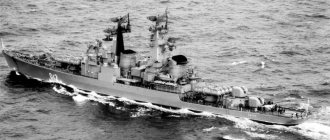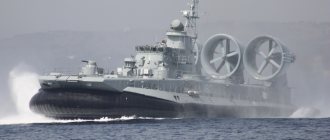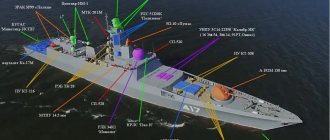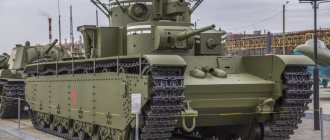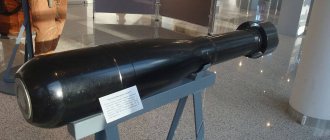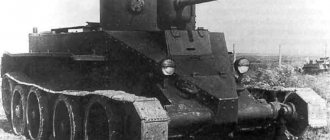Since the advent of aviation, its role in military conflicts has been increasing. Superiority in the sky largely determined the success of military operations. Accordingly, the bases for aircraft and helicopters, including aircraft carriers, developed.
Aircraft carriers gradually became the central objects of fleets. A wide range of tasks solved by aviation required the support of auxiliary ships. Measures were taken to protect against submarines that could quickly take a ship with all its aircraft out of battle.
The heavy aircraft-carrying cruiser (TAVKR, TAKR) “Admiral of the Fleet of the Soviet Union Kuznetsov” is a ship of Project 1143. Designed to counter submarines, it carries helicopters and airplanes on board. Capable of solving many combat missions in support of allied ships and ground forces.
History of the creation of the Admiral Kuznetsov aircraft carrier
"Admiral Kuznetsov" on the roads
The history of the development of the vessel "Admiral Kuznetsov" is connected with the development of project 1143 "Krechet". The first developments to create our own aircraft carrier were carried out even before the Great Patriotic War. However, even after its completion, the project of anti-submarine cruisers was postponed.
Only in 1968 was a government decree issued to begin designing the Project 1143 anti-submarine cruiser. The new ships were initially required to have aviation that could fight submarines, as well as land and cover troops. The emphasis was on helicopters.
Several variants of new vessels were developed. Of these, we chose 1123, which was compatible with earlier projects, which allowed us to reduce costs and complexity of development. A new type of cruiser was approved on April 30, 1970. Within 10 years, 4 such ships were built.
The next three ships became a modernized version of the project. To strengthen counteraction to a potential enemy in the air, the need arose for a full-fledged take-off deck for fighter aircraft. Accordingly, the new ships, instead of missile and artillery installations, received an enlarged runway and a springboard.
The aircraft-carrying cruiser Admiral Kuznetsov became the fifth ship in the series (1143.5) and the first among three modified versions. During all this time, it changed several names - in the project it was listed as “Soviet Union”, when laid down - “Riga”, when launched - “Leonid Brezhnev”, during testing - “Tbilisi”. On October 4, 1990, the ship was named in honor of the Soviet admiral Nikolai Gerasimovich Kuznetsov.
The keel of the cruiser took place on September 1, 1982 at the Black Sea Shipyard in Nikolaev. The ship was designed to accept modified Su-27, Su-25 and MiG-29. For the first time in the USSR, construction was carried out by forming a body from large blocks weighing up to 1400 tons.
On December 4, 1985, the ship was launched, but internal work on its construction continued. On June 8, 1989, mooring tests began, and on September 8 of the same year, the crew moved into the cruiser. On October 21, the ship went to sea, and on November 1, tests with aircraft takeoff and landing began. Throughout 1990, the ship was being completed and its testing continued.
The Admiral Kuznetsov was officially enrolled in the Northern Fleet on January 20, 1991. In November of the same year, the cruiser, based in the Sevastopol roadstead, received a telegram from the Chairman of the Verkhovna Rada of Ukraine L. M. Kravchuk about joining the Ukrainian fleet. The ship's commander, Viktor Yarygin, left the raid and bypassed Europe and made the transition to Vidyaevo, in the Murmansk region.
"Admiral" was stolen
The heavy aircraft-carrying cruiser Admiral of the Fleet of the Soviet Union Kuznetsov was laid down at the Black Sea Shipyard in 1982, launched in 1985 and has been in service since 1990.
The main characteristics of the ship are as follows: length - 302.3 meters, width - 72.3 meters, draft - 9.1 meters, maximum speed - 29 knots, displacement - 60 thousand tons, crew - about 2 thousand people (of which 600 pilots and aircraft technicians), cruising range - 8400 miles. The aircraft carrier can be based on: 26 Su-33 and MiG-29K fighters, 18 Ka-27 and Ka-29 helicopters, two Ka-27PS helicopters and four Ka-31 helicopters.
The ship's armament consists of two Udav rocket launchers, 12 Granit anti-ship missile launchers, 6 six-barreled 30-mm artillery mounts, 4 six-barreled Kinzhal anti-aircraft missile systems and 8 Kortik anti-aircraft missile and artillery systems.
On December 1, 1991, at 9.00, this huge ship quietly weighed anchor in Sevastopol Bay and began moving towards the Bosphorus. The departure was sudden. Cargo, half the crew and planes remained on the shore. Everyone who was on board the Admiral Kuznetsov realized that the ship was being secretly removed from Ukrainian waters. A year and a half later, the newspaper “Severny Rabochiy” published the memoirs of captain 2nd rank Viktor Kanishevsky, who was a participant in the campaign from Sevastopol to Severodvinsk. Here is an excerpt from this article:
“... I remember now the excitement of that autumn day when we received a telegram from the President of Ukraine Kravchuk at Kuznetsov. It announced that the ship was the property of Ukraine, and that until a government decision was made it should remain in the Sevastopol roadstead.
Having broken up in groups in their cabins, the officers, and just sailors, wondered how Russian President Yeltsin, Navy Commander Chernavin and Northern Fleet Commander Gromov would react to this.
“I just can’t figure it out: why does Ukraine, with its closed Black Sea, need a ship intended for ocean service? If she really wants to have an aircraft carrier, then let “Varyag” complete construction or “Ulyanovsk,” the commander of the warhead-5, captain 1st rank Andrei Utushkin, was perplexed. - This is pure politicking...
“Not without that,” 1st Rank Captain Vladimir Ivanov agreed with him. “Only Russia will never give up Kuznetsov.”
However, the declaration of independence of Ukraine, adopted shortly before the ill-fated telegram, had already destroyed the seemingly indestructible maritime brotherhood of the aircraft carrier crew. Some of the officers and midshipmen, whose families were in Sevastopol, did not hide their desire to serve under the Ukrainian “trident”, and therefore openly rejoiced at the telegram. Like, why ruin such a beautiful ship in the North. He needs to be based closer to the repair base. And it is available for an aircraft carrier only in Nikolaev...
Days passed. Kyiv was silent. Meanwhile, a radio dispatch came from the Arctic that the first deputy commander of the Northern Fleet, Vice Admiral Yuri Ustimenko, had flown to Crimea. The long-awaited guest arrived on the aircraft carrier by boat. Despite the late hour, a large gathering was played. Having greeted the crew, the vice admiral with a Ukrainian surname ordered the sailors to be dismissed and ordered the commander to immediately weigh anchor. Yarygin began to explain that two-thirds of the officers and midshipmen, as well as the delivery team, remained on the shore and would arrive by boat only tomorrow morning.
— What about the planes that remained in Saki? — political officer Ivanov became worried.
“They’ll fly to Safonovo themselves,” Ustimenko reassured. Judging by the decisive tone of the guest, one could conclude that he received an order to take “Ukrainian property” to the North not only from the commander of the Northern Fleet Gromov, but also from the Commander-in-Chief of the Navy Chernavin. Or maybe even the Minister of Defense himself. This means that Moscow gave the go-ahead. The management officers of the aircraft-carrying cruiser felt like participants in an unannounced disagreement between two capitals that were still friendly yesterday.
At 23.40, without giving any signals, the aircraft carrier left the Sevastopol roadstead in pitch darkness and headed for the Bosporus. When the shore was far astern, the running lights were turned on...”
Captain 2nd rank Viktor Kanishevsky was the assistant commander of the ship and was responsible for the “survivability” of the ship. He belonged to the senior command staff and knew the situation well. Junior officers and sailors looked at this “northern campaign” with different eyes.
Cruiser design
View of the cruiser from the front, rear and top.
In the design of Project 1143 ships, two key types should be distinguished - the first ships with missile and artillery weapons in the bow and a modernized version with an extension of the runway. “Admiral Kuznetsov” belongs to the second category, although most of the layout schemes retain aspects traditional for the series.
Constructive protection
The protection of the cruiser "Admiral Kuznetsov" is based on two key factors - weapons capable of hitting shells fired at the ship, and design features of the layout and materials used.
To counter missile and bomb attacks, there are anti-aircraft missile systems (SAM) "Dagger", "Kortik" installations and rapid-fire AK-630M. Multi-level protection is provided against torpedo attacks through two RBU-12000 installations. It includes:
- creation of false acoustic targets;
- formation of anti-torpedo minefields;
- hitting torpedoes with depth charges in the immediate vicinity of the ship.
Rolled steel is used to protect the ship, and there are also dry compartments for duplicating the hull. The large number of bulkheads provides 4.5 m of torpedo protection capable of withstanding the equivalent of a 400 kg TNT explosion below the waterline. All this allows you to repel attacks on the cruiser on your own, without the involvement of support ships.
Frame
The welded hull of the cruiser "Admiral Kuznetsov" is made according to the general standards of aircraft carriers. The island with the superstructure is shifted to the right from the longitudinal axis of the ship. The flight deck has a cantilever overhang. Below it are hangars, from which there are two lifts for aircraft. These rooms occupy up to 50% of the length and 70% of the width of the building.
According to the basic project 1143, weapons were located in the bow of the vessel. The Admiral Kuznetsov aircraft carrier has a different layout; in its place there is an additional take-off deck for standard aircraft. The design of the bow section also changed accordingly; the cruiser began to look more like a full-fledged aircraft carrier.
Decks
Diagram of the cruiser and its components.
The total number of decks, including command decks, is 7. For aviation, the initial design of the cruiser included only one corner deck for aircraft takeoff and landing. Such ships were primarily oriented towards helicopters and vertical take-off aircraft. However, this specialization has been revised.
The Yak-38 aircraft did not provide the required striking power and air superiority. Moreover, in the southern latitudes, due to humidity and high temperature, they could not take off at all. This aspect also called into question the effectiveness of helicopters for combating submarines, landing and covering ground troops.
In this context, the new ships were equipped with a direct takeoff and landing deck with a ski-jump, capable of serving standard aircraft. For this purpose, the weapons were removed from the bow, and the design changed towards an aircraft carrier layout.
Aviafinisher "Svetlana-2"
An aircraft finisher is a device for enhanced braking of aircraft landing on the deck of an aircraft carrier. For “Admiral Kuznetsov” the Svetlana-2 system is used. It consists of several transverse cables connected to a hydraulic braking system.
Navigation and optical system
Project 1143 included a comprehensive navigation system developed by the Baku Electromechanical Institute. It included the following devices:
- “Strelna-1” is a central computing system provided by the Azov digital computer;
- the heading system is formed by two Mayak gyrocompasses, two Minute gyroazimuth horizons and the Sumgayit heading calculation system;
- "Katekh-S" measured the speed and drift angle;
- receiver indicators KPF-3K, Pirs-1, KPI-6F received information from radio navigation systems “Route”, “Bras”, “Decca”, RSDN-3, Laurent-A and Laurent-S;
- the Vaygach two-antenna system determined the location and movement of targets.
Modernization of navigation and optical systems has replaced most of the equipment. The basis is the Beysur navigation complex. Surveillance equipment is also represented by modern radar systems.
How did the floating dock sink?
At the same time, the 50-ton tower crane of the floating dock fell on the aircraft-carrying missile cruiser, breaking through the deck in the aft part and several compartments below it, but the cruiser, thanks to the crew’s struggle for survivability, remained afloat, and the dock sank.
Interesting materials:
How to make a home network Win 10? How to make an additional OKVED the main one? How to obtain an electrical safety permit? How to access the microphone? How to access a folder on another computer? How to make Dota in windowed mode? How to make a power of attorney for the right to sign documents? How to make a different font on your Instagram profile? How to make a duplicate of a check at the terminal? How to make a duplicate key using plasticine?
Armament
A simplified diagram of the cruiser with an emphasis on armament.
The armament of the cruiser "Admiral Kuznetsov" is conventionally divided into three categories:
- aviation, including airplanes and helicopters;
- means of destruction of ground, surface and air targets;
- anti-submarine systems.
Taking into account all types of weapons, the ship is designed to participate in a global confrontation, including the use of nuclear weapons. Outside of such scenarios, the ship is capable of providing cover for ground operations in local conflicts.
Aircraft
The question of how many aircraft are on the Admiral Kuznetsov aircraft carrier has an ambiguous answer. In accordance with the project, the cruiser's aviation group includes 50 aircraft and helicopters:
- 26 MiG-29K or Su-27K fighters;
- 4 Ka-27RLD helicopters;
- 18 Ka-27 or Ka-29 anti-submarine helicopters;
- 2 Ka-27PS helicopters.
The actual aviation group consists of:
- 14 Su-33 fighters;
- two training attack aircraft Su-25UTG;
- 10 MiG-29K fighters;
- 4 MiG-29KUB fighters.
The composition of the aviation group changes depending on the tasks assigned to the cruiser. For example, if it is necessary to land and support infantry, the emphasis shifts to helicopters.
Anti-ship missile "Granit"
The aircraft carrier cruiser is equipped with 12 4K89 Granit anti-ship systems. The launchers are located under the diving board at the bow of the ship. Putting them on alert and opening the airlocks cancels flights.
The missiles are capable of hitting targets at a distance of up to 700 km, with a throw weight of 750 kg. Initially they were designed to destroy surface targets, but subsequent modernization made them an effective weapon against ground targets.
SAM "Dagger"
To counter air raids, Admiral Kuznetsov has 24 launchers of Kinzhal anti-aircraft missile systems. The ammunition load is designed for 192 missiles. Designed to destroy air targets in the near zone.
ZKBR "Kortik"
In addition to the Kinzhal air defense system, the cruiser is equipped with Kortik anti-aircraft missile and artillery systems (ZRAK). There are 8 such installations, aimed at defeating enemy high-precision missiles, air targets, as well as small surface and ground objects. The total ammunition load is 256 missiles.
Depth charges
To combat submarines and torpedo attacks, there are two RBU-12000 Boa constrictor rocket launchers. The complexes are stationary, have two guidance planes with ten barrels. Ammunition - 60 depth charges.
AK-630
As additional weapons, the cruiser is equipped with six AK-630 naval artillery mounts. Each has 6 30 caliber barrels. Designed for self-defense, capable of hitting air targets at a slant range within 4 km and light surface targets within a radius of 5 km. The ammunition load includes 48 thousand shells.
Description of the ship
A design feature of the Kuznetsov was the absence of steam catapults on the take-off deck - they were replaced with a springboard. This solution saved weight and usable space and had a positive effect on survivability. But this does not make it possible to use the entire flight deck for launch, and aircraft with insufficiently powerful engines simply cannot take off from a ski-jump.
This led to the emergence of a serious weakness of the aircraft carrier - the air group did not have specialized reconnaissance aircraft with a long range. Later, the problem was solved by installing “electronic reconnaissance containers” on carrier-based fighters. However, they still depend on control from the ship, and containers with various equipment are placed not on one fighter, but on a group of three.
The ship's power plant was eight boilers and four steam turbines. There is nothing unusual in such a system, but at one time it served as a reason for criticism of the ship. The smoke observed by journalists from the chimney of the only Russian aircraft carrier was regarded as a sign of the poor condition of the Admiral Kuznetsov.
The only thing is that the cruiser’s boilers run on fuel oil. And when the ship is stationary, the engines operate in a mode in which carbon deposits are deposited in the pipe.
Of course, fuel oil boilers do not provide unlimited cruising range like nuclear reactors, but they are simpler and much cheaper to maintain. And the fuel-filled compartments are part of the anti-torpedo protection system.
When the aircraft carrier was developed, it was designed to be resistant to close explosions of nuclear weapons (with a yield of up to thirty kilotons). It was expected that the flight deck would, in any case, become unusable due to radioactive contamination, and enemy ships would have to be hit with Granit missiles.
Anti-torpedo protection consists of many bulkheads and compartments with fuel oil, alternating with empty ones. It is designed to protect against explosions equivalent to 400 kg of TNT.
In order for the aircraft carrier to attack enemy ships without scrambling aircraft and without resorting to the services of escort vessels, it was armed with long-range heavy P-700 Granit missiles.
The missiles were never used for their intended purpose. It seemed likely that the Granites would be modified to attack ground targets, but judging by the fact that the launchers have already been dismantled, it will not be carried out.
The cruiser's air defense is provided by Kinzhal anti-aircraft missiles, Kortik missile and gun launchers and six-barreled AK-630 automatic guns of 30 mm caliber. To protect against enemy torpedoes and submarines, the Boa Constrictor rocket launcher is used.
Initially, the Admiral Kuznetsov air group was supposed to consist of deck-based modifications of the Su-27 heavy fighter, the light MiG-29 and the Su-25 attack aircraft.
In fact, throughout the 90s, only “dryers” were used, with the Su-25 only in a training version.
MiG-29K fighters began to be delivered only in 2015, and they are expected to replace the majority of Su-33s. The remaining “dryers” are supposed to be used as attack aircraft, increasing their bomb load. Most of the aircraft carrier's helicopters are anti-submarine Ka-27PL, with a recent addition being the attack Ka-52K.
Specifications
Technical characteristics of the ship
Taking into account the distinctive features from previous ships in the series, the characteristics of the aircraft-carrying cruiser Admiral Kuznetsov are considered separately. This applies to electronic equipment, dimensions, and some other aspects.
Electronic equipment and weapons
After modernization, many systems on the cruiser Admiral Kuznetsov were replaced. The Beysur complex is used for navigation. Electronic equipment includes about 60 types of various systems.
Among them are the BIUS "Lesorub", the "Mars-Passat" complex, the three-dimensional radar "Fregat-MA", the radar for low-flying targets "Podkat", the communication system "Buran-2" and the electronic warfare complex "Constellation BR". Aviation control is provided through Resistor-K42 and Lawn.
Power plant
The power plant of the cruiser is boiler-turbine, four-shaft. There are four GTZA TV-12-4 and eight KVG-4 boilers. The power of each of the four steam turbines is 50 thousand liters. With. Nine turbogenerators and six diesel generators produce 1500 kW each. Four five-blade propellers are used as propulsors.
Cruising range
The aircraft carrier cruiser Admiral Kuznetsov is capable of speeds of up to 29 knots (54 km/h). With this value, the range is 3850 miles. The ship's economical combat speed is 18 knots (33 km/h), allowing it to cover a distance of 7,680 miles. The usual economical speed is 14 knots (26 km/h), with which the ship is capable of traveling 8,417 miles. The ship's overall navigation endurance is 45 days.
Displacement
"Admiral Kuznetsov" has several displacement indicators depending on the load:
- standard - 46540 tons;
- normal - 53050 tons;
- total - 59100 tons;
- the largest - 61390 tons.
Depending on the weight, the draft of the ship also differs. Its values are 8.05, 8.97, 9.76 and 10.4 meters at standard, normal, full and maximum displacement, respectively.
Dimensions and weight
The dimensions of the aircraft carrier cruiser, according to Wikipedia, have the following technical characteristics:
- length of the vessel along the waterline is 270 m, maximum length is 306.45 m;
- width along the waterline - 33.41 m, greatest - 71.96 m;
- maximum height - 64.49 m.
When measured from the waterline, the height has different values. At the bow it is 31.42 m, at the midships and stern it is 25.7 m. The weight of the ship corresponds to its displacement.
What is the difference between an aircraft carrier and an aircraft-carrying cruiser?
Despite the layout of the aircraft carrier, the Admiral Kuznetsov remains an aircraft-carrying cruiser.
The aircraft-carrying cruiser Admiral Kuznetsov is the only ship with aircraft on board capable of being in the Black Sea. The corresponding right is given to him by the Montreux Convention of 1936, which prohibits the entry of aircraft carriers into this water area. This document also defines the concept of such ships.
In accordance with Article 11 of the Montreux Convention, an aircraft carrier is a ship built and equipped for aviation operations. Displacement doesn't matter. If the main purpose of the ship is not aviation, then even if it has a flight deck, it is not considered an aircraft carrier.
The presence of the Granit anti-ship missile system on board the Admiral Kuznetsov classifies the cruiser as a battleship, which allows its passage through the Bosporus and Dardanelles. Moreover, Article 19 of the convention allows for the presence of full-fledged Russian aircraft carriers in the Black Sea in the event of a war with a Black Sea state. Turkey can close the straits to help it, but only after agreement with the League of Nations, which does not exist.
In this context, attention is paid to the combat missions of an aircraft carrier cruiser:
- air defense of escort ships;
- safety of submarines and counteraction to them by the enemy;
- detection and destruction of enemy surface forces;
- support and cover of landing operations.
These aspects relegate the role of aviation to the background. Aircraft combat missions largely involve protecting the ship from enemy aircraft. As a result, the key difference between an aircraft carrier cruiser and an aircraft carrier is the weapons and the range of tasks performed.
Through the eyes of junior officers and sailors
There are three posts on the Balancer forum in which the authors share their impressions of the Admiral Kuznetsov’s voyage from Sevastopol to the village of Vidyaevo, the home base of the aircraft-carrying cruiser in the Northern Fleet.
A visitor under the nickname Oldcondor reports: “...We got into such a mess for three weeks that I don’t even want to remember. Half of the crew was recruited from other ships, the other half - all sorts of engineers, adjusters from the factory, special forces, Black Fleet headquarters officers, etc. There were even border guards and some kind of coast guard from Sevastopol.
And just in case, we have eight tiers of superstructure, seven decks and two platforms. All this is divided into 53 gatherings. Nobody really knows the geography of the ship. The personnel - blind kittens - poke around all the decks. You can't send anyone anywhere. The messenger will definitely get lost, and then you need to declare a “driven hunt” to find the wanderer... However, you don’t have to declare a hunt, the person will get hungry and return to the people himself. True, there is a danger that this sailor will be sheltered by “compatriots”, then he will sleep for two days, take time off from his watch, and this, given the lack of people, is not welcomed by the authorities...”
— “Countrymen” is a unique invention. — A forum member under the nickname Capitan Sidor continues his memories. — On the Kuznetsov, fraternities appeared already on the second day of the move, immediately after the Bosphorus. The entire crew was divided into “Russians”, “Khokhlovs”, “Moldavians”, “Georgians” and “Balts”. There were also, it seems, some Asians: either Tajiks or Uzbeks, I don’t remember exactly. The crests always wanted to flee to their homeland. When leaving the Bosphorus, they threw three rafts overboard and tried to get to the Turkish coast en masse. Everyone, of course, was caught and hidden in a punishment cell all the way to Vidyaevo...
The Georgians stole everything from the galley. Once, while loading food, a whole beef carcass was taken away under the nose of the watch officer... They had their own kebab shop on the fourth tier, where there were empty cabins for pilots and landing troops. The guys traded briskly...
Moldovans are a peaceful, uncomplaining people. Everyone concentrated in the boatswain's team and did not cause us much trouble. But the Estonians and Latvians immediately went into the “catacombs” - to the lowest tiers - it was impossible to drive them up..."
The security company - the ship's riot police - was fully involved in the campaign. The guys guarded the white bone on the “island” (command superstructure - author) and guarded it well. No one moved anywhere without riot police. Only Sreznevsky, the commander of the warhead-6, was not afraid to go below the 4th tier... All other officers faced inevitable reprisals. They, as a rule, were undressed and robbed in the dark...”
You cannot treat messages on forums as reliable facts and, especially, as a historical source. Anonymous correspondents have impunity for their writings. They say what they want. There is no responsibility. However, the statistics of negative reviews about the latest aircraft-carrying cruiser built in Nikolaev makes us think.
How many aircraft carriers and aircraft-carrying cruisers are there in Russia?
Taking into account the economic situation, almost all ships of Project 1143 were sold or dismantled. "Admiral Kuznetsov" remained the only aircraft-carrying cruiser in service with the Russian Federation. The fleet also does not have full-fledged aircraft carriers.
Discussions about the development of weapons in this direction have been ongoing since the 2000s. Without aircraft carriers, Russia cannot have a sufficiently powerful fleet. However, their design and assembly require significant financial costs. There is also no equipped shipyard capable of assembling new ships.
Taking into account the fact that Admiral Kuznetsov has been sent for modernization until 2022, the issue of aircraft carriers remains relevant. Existing developments are focused on the creation of such ships with nuclear reactors. The Storm and Manatee projects may turn out to be promising, but they require significant funds, which the Ministry of Defense cannot yet allocate.
Why is construction delayed?
The construction of the dock for the modernization of the Admiral Kuznetsov is delayed for several reasons, Valery Kireev, deputy head of the Center for Shipbuilding and Ship Repair Technology (TSTSS), which has the status of a state research center and serves as the general designer of the dry dock, told RBC.
- Conflict between contractor and customer. Despite the lack of approved design and estimate documentation, it is already possible to carry out a large amount of work on the shore at the second stage - to equip the site, dismantle structures, etc., but there is actually no contractor at the construction site, notes Kireev.
- The second reason is related to the increase in the planned cost of the second stage of construction. TsTSS doubled it in December 2022, says Kireev, due to the identified increased seismicity for the dry dock of 7.9 points (usual seismic maps in the region provide for 6 points). Initially, the cost of the second stage was 16 billion rubles, the new price is 33.6 billion rubles, a source close to the project told RBC. USC and the Ministry of Industry and Trade refuse to agree on a new price, explains the deputy head of the designer. Because of this, according to him, Glavgosexpertiza cannot begin checking the documentation.
In response to the request of the Ministry of Industry and Trade to reduce the cost of the project, the TsTSS proposed to abandon measures worth 5 billion rubles that are not directly related to the dry dock, but have not yet received consent from the ministry and the customer, Kireev said. According to him, the Ministry of Industry and Trade instructed the customer to hire a third-party organization to check the calculations of the central heating system. Increased seismicity has already been included in the documents for the first stage, defends the position of TsTSS Kireev, and the accuracy of the calculations in 2022 was confirmed by scientists from the TsNIIP of the Ministry of Construction of Russia and Glavgosexpertiza.
USC is clarifying the seismicity of the construction site to optimize design solutions for the second stage in order to prevent a significant increase in the cost of the dry dock, a representative of the corporation told RBC. A representative of the Ministry of Industry and Trade declined to comment.
Operation of the Admiral Kuznetsov aircraft carrier
"Admiral Kuznetsov" under repair
The operation of the aircraft-carrying cruiser "Admiral Kuznetsov" was initially carried out in difficult economic conditions. The first period is characterized by lengthy tests and lengthy repairs. Later, the emphasis shifted to participation in exercises and combat duty. Restoration work is carried out after each major transition.
Participation in exercises and combat conditions
The first stage of the ship's operation took place from 1992 to 1994; at the end of 1995, the ship entered combat service in the Mediterranean Sea, then spent almost two years under repairs.
In 1998, the cruiser took part in large-scale exercises, and in 1999, it underwent combat training twice. Participated in the 2000 exercises, in which the K-141 Kursk sank, and took part in search and rescue operations.
In 2001-04 the ship was undergoing scheduled repairs. Then he took part in a month-long voyage to the North Atlantic as part of several other ships. In 2005-07 he continued to carry out combat service, after which until 2008 he again led the voyage of a group of ships to the Atlantic Ocean and the Mediterranean Sea.
After the voyage, a new major overhaul was carried out, updating a number of ship units. In 2011, together with several ships of the Northern Fleet, it sailed to the shores of Syria; the voyage ended in 2014. In 2015 and 2016 it was undergoing restoration repairs.
At the end of 2016 and beginning of 2022, Admiral Kuznetsov carried out combat missions off the coast of Syria. About 420 combat sorties were carried out from the ship with attacks on terrorist positions. In February 2022, the ship returned to its permanent location in Severomorsk. On February 23, 2020, the cruiser received the Order of Ushakov.
In 2017-20, the ship is undergoing modernization and replacement of a number of equipment. It is expected that after completion of the work, the service life of the vessel will be increased by 10 years. Return to the fleet is targeted for 2022. How long this work will last in practice is unknown.
Our dear TAVKR "Admiral of the Fleet of the Soviet Union Kuznetsov"
The fire that broke out on December 12, 2022 on the heavy aircraft-carrying cruiser Admiral of the Fleet of the Soviet Union Kuznetsov was a big blow for everyone who is not indifferent to the current state of the Russian Navy.
We mourn the death of two people who gave their lives fighting the fire and wish a speedy recovery and restoration of strength to all fourteen victims, seven of whom were hospitalized. It is well known that this emergency is already the second during the repair of the TAVKR, which began in October 2022. On the night of October 30, 2022, the floating dock PD-50, in which Kuznetsov was located, sank. Alas, there were human casualties here too. One person went missing and has not yet been found - VO readers undoubtedly understand what this means. Of the other four victims, one died in a hospital in Murmansk.
Of course, in addition to the people in these emergencies, the ship itself was also damaged. During the fire on December 12-13, the flames engulfed an area of 600 (according to other sources - 500) square meters, the premises in this area burned out. The head of the USC, A. Rakhmanov, has so far refrained from assessing the damage, saying that even approximate amounts can only be discussed in two weeks, that is, after a preliminary assessment of the damage, which is currently being carried out by specialists.
However, an unnamed source from USC reported that, according to preliminary data, the damage was much less than expected. According to him, household premises with garbage in them burned out (why it was not cleared away before welding work was carried out is a separate question), but neither the auxiliary diesel generators nor the containers with diesel fuel and engine oil located near the fire were damaged. So, perhaps, this time the ship itself escaped with only a “mild fright.” As for the death of the PD-50, fortunately, for such a large-scale disaster, the ship suffered surprisingly little: the deck and several interior spaces were damaged when a 70-ton crane fell on it.
The same crane, on the same deck
Perhaps this is why A. Rakhmanov is very optimistic about the timing of the return to service of our only TAVKR. So far we are talking about moving these dates “to the right” by no more than a year, that is, if it was initially assumed that the ship would return to the fleet in 2022, now 2022 is mentioned.
Meanwhile, in the electronic media
The fire on December 12-13 turned into a kind of trigger for many Internet publications with heartbreaking titles like: “Stop tormenting him already.”
Their essence boils down to the fact that an aircraft-carrying cruiser does not need to be commissioned. The arguments are given as follows. "Kuznetsov" is a classic suitcase without a handle. It is clear that an aircraft-carrying ship is a status thing, and I want to preserve it as part of the fleet. But the TAVKR is practically not combat-ready, and is only suitable for training carrier-based aviation pilots, and the ongoing repairs will not change this fact. We won’t be able to assemble an aircraft carrier group for it either, because the Northern Fleet simply doesn’t have enough surface ships. That is, the TAVKR has no military potential, and the costs of its repair and maintenance are high, and maybe even huge. It’s better to use the same money to build a pair of Ashes or Boreevs, which will be much more useful to our fleet.
This refrain comes in many variations. For example, if the repair of the TAVKR had gone according to plan, then everything would have been fine, but the sinking of the only floating dock where the Kuznetsov could be repaired in the north leads to the need to build a new one, and taking into account these additional costs, the return of the TAVKR- but once in operation it no longer looks rational.
There is also a more radical position. That the USSR and the Russian Federation simply “could not become aircraft carriers.” The design of the ship is bad, they haven’t learned how to operate it, there are constant mistakes with one thing or another, and in the Mediterranean it smokes, and planes suffer disasters, and arresting devices break, and even repairs are a complete mess. In general, this is not ours, and in general, aircraft-carrying ships are a weapon of aggression against banana republics, which in the era of hypersonic missiles have become outdated as a class. We don’t need aircraft carriers, we’ll make do with daggers... oh, sorry, “Daggers”, “Zircons”, submarines and a “mosquito” fleet.
Let's try to make sense of all this. And for starters...
How much does it cost to repair a TAVKR?
A variety of amounts have been cited in the open press regarding this matter. For example, in 2022, TASS reported that the cost of repairs and modernization of Kuznetsov would be about 40 billion rubles. Then a figure of 50 billion was named. In May 2022, according to Interfax, it increased to approximately 60 billion rubles. However, this did not become the final figure - according to the head of USC A. Rakhmanov dated December 10, 2022, the amount required to repair the ship has increased even more. Unfortunately, A. Rakhmanov did not specify how much.
Why are the amounts for ship repairs growing so strangely – by one and a half times or more?
Anyone who has had at least a little experience with production can answer this question without any problems. Let's start with the fact that it is impossible to absolutely accurately plan the cost of repairing a complex industrial product. It will be clear only after troubleshooting the components and assemblies being repaired, that is, after they have been disassembled and seen what is inside, which parts require repair, which need to be replaced, and which will still serve.
It is well known that a ship is a very complex engineering structure with a lot of mechanisms on board. Each of these mechanisms has its own resource, its own need for scheduled repairs of varying degrees of complexity. And if the schedule of scheduled preventative repairs is carried out strictly, then the condition of the ship is quite predictable and understandable. Accordingly, it is not so difficult to plan the costs of the next repair. Of course, there will still be some deviations, but they will be relatively insignificant, not by tens of percent.
But if the ship over and over again “flew” past the “capital” allotted to it according to the plans of the creators, limiting itself to average or even cosmetic repairs, or even without it at all, if the financing of even these “half-hearted” repairs was stretched out, the quality of the components was not guaranteed, and etc., it will be extremely difficult to predict repair costs. You disassemble the unit, believing that two parts will need to be replaced, but it turns out there are five. Moreover, during disassembly it also turns out that the other mechanism with which this unit interacts also requires urgent repair. And you didn’t even plan it, since it worked properly. But then they opened it, saw what was inside and grabbed their heads, because it was completely unclear why it hadn’t exploded and killed everyone around it.
This is exactly what happened with our “Kuznetsov”. Let me just remind you that for almost 27 years from the moment it entered service until it was placed for repairs in 2022, the TAVKR did not receive a single (!!!) major overhaul. Many VO readers complain that the TAVKR sits idle a lot against the wall, but, excuse me, the way you service the equipment is how it serves you.
And therefore, it is not at all surprising that until the limits and volumes of necessary work were determined according to TAVKR, and until defective statements were compiled for all components and assemblies being repaired, the total cost of repairs grew by leaps and bounds. There is no need to see this as some kind of excessive greed of USC: it is clear that the company’s managers will not miss theirs, but in this case, the increase in the cost of repairs has completely objective reasons. So, the process of identifying defects was finally completed in November 2018 and, although exact figures have not been announced, it can be assumed that the cost of repairing the Kuznetsov TAVKR, excluding the costs of eliminating the consequences of the fire and, probably, the fall of a 70-ton crane on its deck will be in the range from 60 to 70 billion rubles.
How much does a fallen crane and fire cost?
How much could the damage to the TAVKR received as a result of the flooding of the PD-50 dock cost?
I’ll answer the question with a question: “And for whom exactly?” The RF Ministry of Defense is not at all to blame for the death of this dock, which means it cannot afford to pay for this damage at all. Maybe the United Shipbuilding Corporation will have to fork out the cash? It’s possible that this is true, but the only thing is that, at first glance, she doesn’t seem to be to blame for what happened. The PD-50 floating dock, as well as the 82nd ship repair plant itself, where the Kuznetsov was repaired, are not part of the USC. This is a “private shop”, the main shareholder of which is the notorious. In October 2018, USC filed a lawsuit against Rosneft in order to compensate for the damage received by the Kuznetsov TAVKR, although how it all ended (and whether it ended) is unknown to the author. But from the point of view of the law, such damage is paid not by the customer, who is the Ministry of Defense, but by the contractor (USC), who, in turn, can recover the amount of damage from the co-performer, which is the 82nd ship repair plant. Whether A. Rakhmanov will be able to recover money from Rosneft or not is certainly an interesting question, but the fall of the crane will not cost anything to the budget of the RF Ministry of Defense.
Interestingly, the same applies to fire. The difference is that here USC is unlikely to be able to overcharge anyone for damages, but the Ministry of Defense will not pay for an emergency that occurred due to the fault of the contractor.
How much does a new dock cost?
This is where it gets really interesting. The fact is that the PD-50, apparently, is no longer possible to put into operation, even if you spend money on its recovery. The structure is quite old, commissioned in 1980, and, apparently, critically deformed by a collision with the ground during flooding.
Floating dock PD-50
Thus, the only option to resolve the issue is the construction of a new dry dock at the 35th ship repair plant (SRZ). More precisely, not construction, but the combination of two separate dry adjacent chambers of the existing dock into one. This will ensure the ability of the 35th Shipyard to repair large-capacity vessels and ships, including the Kuznetsov TAVKR.
Of course, the pleasure is not cheap. According to experts, such work will cost the country approximately 20 billion rubles. And then those who prophesy the speedy disposal of our country’s last TAVKR engage in simple arithmetic: “60 billion rubles. for the repair of the cruiser, and 10 billion for repairing damage, and 20 billion for the cost of the dock... Oh, not profitable at all!”
Well, we have already dealt with the costs of eliminating a fire and a falling crane. The costs are significant, but the Russian Defense Ministry will not bear them, so in this calculation they are equal to zero. What about the costs of building a dock?
For some, this may sound strange, but in calculating the costs of returning the TAVKR to service, the costs for a new dock are equal (the author makes a mysterious face) exactly 0 (ZERO) rubles, 00 kopecks. Why?
The whole point is that the costs of building, or rather, rebuilding the dock could be added to the cost of repairing the TAVKR only in one case: if this modernized dock was needed only and exclusively for Kuznetsov and for nothing else. But the same PD-50 existed and served many different ships, and not only the Kuznetsov TAVKR.
Heavy nuclear missile cruiser "Peter the Great" in PD-50
Our fleet in the north, both military and civilian, needs a large dock for large ships and vessels, and we no longer have it. And therefore, regardless of whether Kuznetsov remains part of the Russian Navy or is withdrawn from it, it is still necessary to create a large dock at the 35th Shipyard.
It must also be said that the modernization of the dock of the 35th shipyard in question was planned to be carried out even when the PD-50 was afloat and, as they say, there were no signs. Moreover, the “guests” of this hydraulic structure were considered not only and not so much even large warships of the 1st rank, but nuclear icebreakers LK-60, whose displacement would reach 33.5 thousand tons. At that time, this was not a priority task, and the modernization of the dock of the 35th Shipyard was planned to begin in 2022. So you need to understand: the death of the PD-50 did not lead to the need to modernize the dock of the 35th Shipyard, but only accelerated the start of work on it by about 3 years.
The need to dock the TAVKR affected only the timing of the start of work, but not the very need to reconstruct the dock of the 35th shipyard - the latter has nothing to do with the presence of the Kuznetsov in the fleet. And if so, there is no reason to tie the costs of building this dock to the cost of repairing our TAVKR. In fact, this is as absurd as, for example, building a tire workshop and offering to pay the full cost of construction to the driver of the first car who comes to use its services.
So how much is it?
It turns out that the repair of the Kuznetsov TAVKR should cost the country approximately 65-70 billion rubles.
But the repair schedule may well move “to the right”, because A. Rakhmanov is very optimistic about the readiness of the “united” large dock at the 35th shipyard. The head of the USC assumed that this would take a year, but, as we already know, in the construction of anything, a year can easily turn into three. In theory, this should even reduce the cost of repairing the Kuznetsov for the Ministry of Defense, since, firstly, a later delivery date for the ship will lead to a shift in the corresponding payments, and due to inflation, the latter may become cheaper (1 billion paid in 2022 and in 2023 – these are two different billions). In addition, the RF Ministry of Defense has the opportunity to fine USC for disruptions to work on the ship. But on the other hand, it is possible that USC will be able to come to an agreement and still compensate for part of its costs for protracted repairs at the expense of the Ministry of Defense. Therefore, it makes sense to assume that ultimately the cost of repairing the Kuznetsov TAVKR will be about 70-75 billion rubles. Is it a lot or a little? It is quite difficult to answer this question. The Project 20380 corvette, laid down in 2022, that is, in the year the Kuznetsov modernization began, would have cost the country about 23 billion rubles. (in 2014 they were contracted at a price of over 17 billion rubles plus inflation). It seems that the promising corvette “Daring” of Project 20386 cost 29 billion rubles according to the 2016 estimate, but next year it would cost 30 billion (despite the fact that in fact it will most likely turn out to be significantly more expensive). The cost of the serial Yasen-M in 2011 was announced at around 30 billion rubles, that is, approximately a billion dollars. But this is the initial price, which, it seems, Serdyukov managed to “push through”; subsequently, it most likely increased. Suffice it to say that the lead boat of Project 885M Kazan was valued at 47 billion rubles in 2011. That is, in terms of today’s money, one serial “Yasen-M” may well cost 65-70 billion rubles. or even more expensive.
In general, I believe we will not be too mistaken if we estimate the cost of repairing the Kuznetsov TAVKR as the cost of building 2-3 corvettes or one multi-purpose nuclear submarine.
TAVKR "Kuznetsov" - not combat-ready?
Let's assume that Kuznetsov was successfully repaired and returned to the Russian Navy in 2022 or 2024. What will the fleet get in the end?
This will be a ship capable of hosting an air regiment (24 units) of multirole fighters of the MiG-29KR/KUBR type.
In fact, the TAVKR could have served an air group of similar size earlier, but for objective reasons it was never possible to “assemble” it on a ship, and there was no urgent need for this. Moreover, even at the time of the Syrian campaign, carrier-based MiGs had not yet been put into service. At the same time, by the beginning of the 20s, the MiG-29KR/KUBR will be fully mastered by carrier-based aviation pilots. General repairs to the TAVKR mechanisms responsible for ensuring the functioning of aircraft, as well as a new takeoff/landing control system will be able to provide them with the necessary maintenance.
The Kuznetsov TAVKR will no longer carry strike weapons. The existing anti-ship missile complex "Granit" is not combat-ready, and equipping the UKSK ship with "Calibers", "Onyxes" and "Zircons" is not included in the repair project. This, in general, is correct, since the key task of the TAVKR is to ensure the operation of carrier-based aircraft, and not strikes with cruise missiles. Of course, the reserves don’t stretch your pocket, the ability to launch a missile strike is obviously better than its absence, but you have to pay for everything. And reinstallation of the launchers, placement of the corresponding combat posts and equipment, re-wiring of communications, integration into the BIUS and other work necessary to equip the Kuznetsov TAVKR UKSK will cost a lot of money.
As for defensive weapons, as far as can be judged from open publications, the Kinzhal air defense systems will remain, although perhaps they will be modernized. But the 8 ZRAK “Dirk” installations will be replaced by “Shells”, probably in the same quantity. It is extremely difficult to say what the speed of the ship will be after repairs. Nevertheless, according to the information available to the author, it can be assumed that, having returned to the fleet, the Kuznetsov will be able to produce at least 20 knots without strain and for a long time, but possibly more.
What can you say about such a ship? Very often in publications and comments on them you have to read the following: in this form, the TAVKR is categorically inferior to any American aircraft carrier and will not be able to withstand the latter in open battle. At the same time, the Americans have 10 aircraft carriers, and we have one Kuznetsov. From here a simple conclusion is drawn: in the event of a war with NATO, our latest TAVKR will not be able to bring any sense.
In fact, this conclusion is completely incorrect. The fact is that the usefulness of a particular weapon should be measured not by “spherical horses in a vacuum,” but by the ability to solve specific problems in very specific conditions. A hunting knife, as a means of destroying enemy personnel, is in all respects inferior to a hunting rifle in the steppe, but in the elevator of a city house the situation changes radically. Yes, an American AUG in a duel situation is, without a doubt, capable of destroying an aircraft carrier multi-purpose group led by Kuznetsov. But the question is that no one will ever set the task for our TAVKR to defeat such an American formation in the ocean.
North Sea Bastion
In the event of a global war, the task of the Northern Fleet will be to create, as it has become fashionable to say, a zone of restriction and denial of access and maneuver A2/AD in the Barents Sea and to the east of it.
This is necessary, first of all, to ensure the safety of the deployment of SSBNs. We are, of course, not talking about assigning a multipurpose submarine and 2 frigates to each strategic submarine cruiser. The Northern Fleet will need to identify, impede and limit the actions of NATO surface and submarine ships, as well as NATO aircraft and helicopters in the Barents Sea. Thus, the likelihood of successful interception of our SSBNs by enemy anti-aircraft missile forces can be significantly reduced. And the same applies to the deployment of domestic nuclear and diesel multipurpose submarines. Simply put, after the naval missile-carrying aviation of the Russian Federation ceased to exist, submarines became, perhaps, the only means capable of causing at least some damage to the enemy. But we have few of them left, and besides, practice has long and repeatedly proven that submarines are unable to fight with properly organized anti-aircraft defense carried out by heterogeneous forces. So, no matter how weak our surface and air forces are, their correct use at the beginning of the conflict will be able to limit the activities of such important elements of NATO anti-aircraft defense as anti-submarine aircraft and hydroacoustic reconnaissance ships - and thereby create additional opportunities and chances for our submariners.
What kind of enemy will we face? According to American military plans that have existed since the times of the USSR, the American AUS (2 aircraft carriers with a bunch of aircraft accepted for overload and with escort ships) was supposed to approach the shores of Norway. There, some of the aircraft were supposed to fly to Norwegian airfields, and then operate against sea, air and ground targets.
In other words, the Americans are not at all trying to get their AUGs into the Barents Sea. Their plan is simpler - ensuring air supremacy with superior masses of aviation (under two hundred carrier-based aircraft), and conquering it under water, saturating the water area with their first-class multi-purpose nuclear submarines, and the airspace with anti-submarine aircraft and helicopters. Can we counter these plans with land-based aviation alone?
Let's take such an important reconnaissance element as an AWACS aircraft. The Russian Federation has such aircraft: we are talking about the A-50, the modernized A-50U, and maybe even the A-100 Premier.
A-50U
Yes, they do not serve in naval aviation, but, according to the author, they are periodically involved in reconnaissance of space over the seas, at least in the Far East, and nothing prevents them from doing the same in the north. The A-50U is capable of patrolling for 7 hours 1000 km from the airfield. This is great, but a Su-30 that took off from the same airfield, even equipped with external fuel tanks, is unlikely to be able to accompany it on patrol for at least an hour. In total, to escort one A-50U, at least 14 Su-30s will be required, provided that a pair of fighters will accompany the AWACS aircraft.
But, for example, the A-50 was discovered by an enemy patrol plane. What to do? Send fighters to attack, while remaining defenseless, since even if successful, the Su-30 will burn fuel, use up weapons, and be forced to return to the airfield? Leave after the attack with them, giving up control of the airspace? It will not be possible to call for reinforcements from the ground - they will arrive too late. There is only one option left - to have not a pair, but four fighters, but then to ensure the operation of one AWACS aircraft you will no longer need 14, but 28 fighters. But this is simply unrealistic - we will not be able to allocate such an air group to support just one AWACS. In summary, we should either abandon the use of long-range radar reconnaissance aircraft at sea, or make it very fragmented, tying patrol time to the capabilities of fighter cover. It is obvious that both options will have an extremely negative impact on the coverage of the air and surface situation.
The task of airspace control is greatly simplified if at sea, in the AWACS patrol area, there is an aircraft-carrying ship with at least one squadron of fighters on board. Its aircraft, even having a smaller combat radius, will still be able to accompany the “flying headquarters” longer simply due to the proximity of the TAVKR to the patrol area. They will be able to react quickly and intercept targets identified during AWACS patrols. Helicopters operating from the TAVKR are quite capable of significantly strengthening control over the actions of foreign submarines at a considerable distance from the coast.
Of course, the Americans are quite capable of detecting and destroying the Kuznetsov in the Barents Sea. But the destruction of the AMG as part of the TAVKR, and at least only 2-3 surface ships supporting it, is a very difficult task that cannot be accomplished at once. This is a complex operation that requires preparation, reconnaissance and additional reconnaissance of the Russian warrant, the organization of a massive air raid, and maybe even more than one... In general, this is an operation that, under the most optimistic assumptions, will take many hours for the Americans. And until the TAVKR is destroyed, or at least put out of action, the mere fact of its existence will seriously limit the actions of NATO anti-aircraft patrol aircraft.
In other words, the presence of an operational TAVKR as part of the Northern Fleet, even with only one to one and a half squadrons of fighters, even without its own AWACS, even with a speed of no more than 20 knots, will significantly increase the situational awareness of the fleet command about the surface and underwater situation in the pre-war period period, and can seriously hamper the actions of enemy anti-aircraft aircraft at least in the first hours of war.
Is it possible to assume that the actions of the TAVKR will save at least one nuclear submarine from destruction in the initial period of the war? More than.
Conclusion
Let's imagine representatives of the Russian Defense Ministry at a crossroads.
There is a certain amount of money (70-75 billion rubles). It is possible to build another modernized Yasen of Project 885M. Or is it possible to maintain the status pennant, gain experience in operating aircraft-carrying ships, continue the development of domestic carrier-based aviation, and, at the same time, not reduce the fleet’s underwater group in the least, because if it comes to war, the presence of all this will protect at least one nuclear submarine from destruction in the very first hours of the war. For the author of this article, the choice is obvious. And for you, dear readers?
